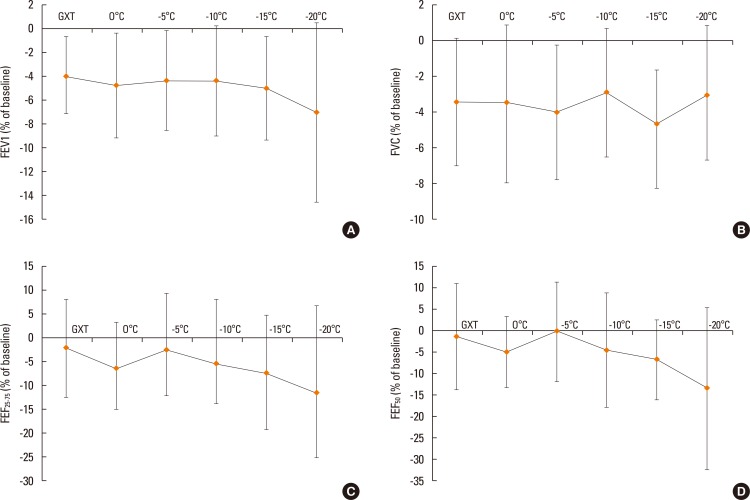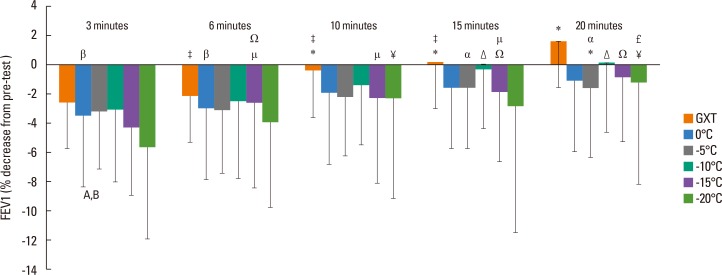Allergy Asthma Immunol Res.
2018 Jan;10(1):43-51. 10.4168/aair.2018.10.1.43.
Respiratory Function and Symptoms Post Cold Air Exercise in Female High and Low Ventilation Sport Athletes
- Affiliations
-
- 1Faculty of Physical Education and Recreation, University of Alberta, Edmonton, Canada. kennedy@ualberta.ca
- 2Department of Sport Science, Medical Section, University of Innsbruck, Innsbruck, Austria.
- KMID: 2428849
- DOI: http://doi.org/10.4168/aair.2018.10.1.43
Abstract
- PURPOSE
Cold weather exercise is common in many regions of the world; however, it is unclear whether respiratory function and symptom worsen progressively with colder air temperatures. Furthermore, it is unclear whether high-ventilation sport background exacerbates dysfunction and symptoms.
METHODS
Seventeen active females (measure of the maximum volume of oxygen [VO(2max)]: 49.6±6.6 mL·kg⻹·min⻹) completed on different days in random order 5 blinded running trials at 0℃, -5℃, -10℃, -15℃, and -20℃ (humidity 40%) in an environmental chamber. Distance, heart rate, and rating of perceived exertion (RPE) were measured within each trial; forced expiratory volume in 1 second (FEV1), forced vital capacity (FVC), forced expiratory flow at 25%-75% (FEF₂₅₋₇₅), and forced expiratory flow at 50% (FEFâ‚…â‚€) were measured pre- and post-test (3, 6, 10, 15, and 20 minutes). Respiratory symptoms and global effort were measured post-test spirometry.
RESULTS
Mean decreases were found in FEV1 (4%-5% at 0℃, -5℃, -10℃, and -15℃; 7% at -20℃). FEF₂₅₋₇₅ and FEF₅₀ decreased 7% and 11% at -15℃ and -20℃, respectively. Post-exertion spirometry results were decreased most at 3 to 6 minutes, recovering back to baseline at 20 minutes. Respiratory symptoms and global effort significantly increased at -15℃ and -20℃ with decreased heart rate. High-ventilation sports decreased function more than low-ventilation participants but had fewer symptoms.
CONCLUSIONS
These results indicate that intense exercise at cold air temperatures up to -20℃ is achievable; however, greater effort along with transient acute bronchoconstriction and symptoms of cough after exercising in temperatures colder than -15℃ are likely. It is recommended that individuals cover their mouth and reduce exercise intensity to ameliorate the effects of cold weather exercise.
Keyword
MeSH Terms
Figure
Reference
-
1. Bergeron MF, Bahr R, Bärtsch P, Bourdon L, Calbet JA, Carlsen KH, et al. International Olympic Committee consensus statement on thermoregulatory and altitude challenges for high-level athletes. Br J Sports Med. 2012; 46:770–779. PMID: 22685119.
Article2. Carlsen KH. Sports in extreme conditions: the impact of exercise in cold temperatures on asthma and bronchial hyper-responsiveness in athletes. Br J Sports Med. 2012; 46:796–799. PMID: 22906782.
Article3. Koskela HO. Cold air-provoked respiratory symptoms: the mechanisms and management. Int J Circumpolar Health. 2007; 66:91–100. PMID: 17515249.
Article4. Quirion A, Laurencelle L, Paulin L, Therminarias A, Brisson GR, Audet A, et al. Metabolic and hormonal responses during exercise at 20 degrees, 0 degrees and -20 degrees C. Int J Biometeorol. 1989; 33:227–232. PMID: 2613366.5. Larsson K, Tornling G, Gavhed D, Müller-Suur C, Palmberg L. Inhalation of cold air increases the number of inflammatory cells in the lungs in healthy subjects. Eur Respir J. 1998; 12:825–830. PMID: 9817153.
Article6. Stensrud T, Berntsen S, Carlsen KH. Exercise capacity and exercise-induced bronchoconstriction (EIB) in a cold environment. Respir Med. 2007; 101:1529–1536. PMID: 17317135.
Article7. Stensrud T, Mykland KV, Gabrielsen K, Carlsen KH. Bronchial hyperresponsiveness in skiers: field test versus methacholine provocation? Med Sci Sports Exerc. 2007; 39:1681–1686. PMID: 17909392.8. Parsons JP, Kaeding C, Phillips G, Jarjoura D, Wadley G, Mastronarde JG. Prevalence of exercise-induced bronchospasm in a cohort of varsity college athletes. Med Sci Sports Exerc. 2007; 39:1487–1492. PMID: 17805078.
Article9. Strauss RH, McFadden ER Jr, Ingram RH Jr, Jaeger JJ, Stearns DR. Enhancement of exercise-induced asthma by cold air. N Engl J Med. 1977; 297:743–747. PMID: 895804.
Article10. Anderson SD, Daviskas E. The mechanism of exercise-induced asthma is …. J Allergy Clin Immunol. 2000; 106:453–459. PMID: 10984363.
Article11. Turmel J, Bougault V, Boulet LP. Seasonal variations of cough reflex sensitivity in elite athletes training in cold air environment. Cough. 2012; 8:2. PMID: 22449054.
Article12. Bougault V, Turmel J, Boulet LP. Bronchial challenges and respiratory symptoms in elite swimmers and winter sport athletes: airway hyperresponsiveness in asthma: its measurement and clinical significance. Chest. 2010; 138:31S–37S. PMID: 20363843.13. Eichner ER. Asthma in athletes: scope, risks, mimics, trends. Curr Sports Med Rep. 2008; 7:118–119. PMID: 18477865.14. Rundell KW, Im J, Mayers LB, Wilber RL, Szmedra L, Schmitz HR. Self-reported symptoms and exercise-induced asthma in the elite athlete. Med Sci Sports Exerc. 2001; 33:208–213. PMID: 11224807.
Article15. Rundell KW, Wilber RL, Szmedra L, Jenkinson DM, Mayers LB, Im J. Exercise-induced asthma screening of elite athletes: field versus laboratory exercise challenge. Med Sci Sports Exerc. 2000; 32:309–316. PMID: 10694112.
Article16. Langdeau JB, Day A, Turcotte H, Boulet LP. Gender differences in the prevalence of airway hyperresponsiveness and asthma in athletes. Respir Med. 2009; 103:401–406. PMID: 19027280.
Article17. McClaran SR, Harms CA, Pegelow DF, Dempsey JA. Smaller lungs in women affect exercise hyperpnea. J Appl Physiol (1985). 1998; 84:1872–1881. PMID: 9609779.
Article18. Miller MR, Hankinson J, Brusasco V, Burgos F, Casaburi R, Coates A, et al. Standardisation of spirometry. Eur Respir J. 2005; 26:319–338. PMID: 16055882.19. Borg GA. Psychophysical bases of perceived exertion. Med Sci Sports Exerc. 1982; 14:377–381. PMID: 7154893.
Article20. Stensrud T, Carlsen KH. Can one single test protocol for provoking exercise-induced bronchoconstriction also be used for assessing aerobic capacity? Clin Respir J. 2008; 2:47–53. PMID: 20298304.
Article21. Castellani JW, Young AJ, Ducharme MB, Giesbrecht GG, Glickman E, Sallis RE, et al. American College of Sports Medicine position stand: prevention of cold injuries during exercise. Med Sci Sports Exerc. 2006; 38:2012–2029. PMID: 17095937.22. Heir T, Oseid S. Self-reported asthma and exercise-induced asthma symptoms in high-level competitive cross-country skiers. Scand J Med Sci Sports. 1994; 4:128–133.
Article23. Herman L, Foster C, Maher MA, Mikat RP, Porcari JP. Validity and reliability of the session RPE method for monitoring exercise training intensity. South Afr J Sports Med. 2006; 18:14–17.
Article24. Pellegrino R, Viegi G, Brusasco V, Crapo RO, Burgos F, Casaburi R, et al. Interpretative strategies for lung function tests. Eur Respir J. 2005; 26:948–968. PMID: 16264058.25. Rundell KW, Slee JB. Exercise and other indirect challenges to demonstrate asthma or exercise-induced bronchoconstriction in athletes. J Allergy Clin Immunol. 2008; 122:238–246. PMID: 18678339.
Article26. Holzer K, Brukner P. Screening of athletes for exercise-induced bronchoconstriction. Clin J Sport Med. 2004; 14:134–138. PMID: 15166901.
Article27. Cappaert TA, Stone JA, Castellani JW, Krause BA, Smith D, Stephens BA, et al. National Athletic Trainers' Association position statement: environmental cold injuries. J Athl Train. 2008; 43:640–658. PMID: 19030143.
Article28. Evans TM, Rundell KW, Beck KC, Levine AM, Baumann JM. Airway narrowing measured by spirometry and impulse oscillometry following room temperature and cold temperature exercise. Chest. 2005; 128:2412–2419. PMID: 16236903.
Article29. Farley RD, Albazzaz MK, Patel KR. Role of cooling and drying in hyperventilation induced asthma. Thorax. 1988; 43:289–294. PMID: 3406916.
Article30. Helenius IJ, Tikkanen HO, Sarna S, Haahtela T. Asthma and increased bronchial responsiveness in elite athletes: atopy and sport event as risk factors. J Allergy Clin Immunol. 1998; 101:646–652. PMID: 9600502.31. Rundell KW, Spiering BA, Baumann JM, Evans TM. Effects of montelukast on airway narrowing from eucapnic voluntary hyperventilation and cold air exercise. Br J Sports Med. 2005; 39:232–236. PMID: 15793094.
Article32. Stensrud T, Berntsen S, Carlsen KH. Humidity influences exercise capacity in subjects with exercise-induced bronchoconstriction (EIB). Respir Med. 2006; 100:1633–1641. PMID: 16446080.
Article33. Cole P. Further observations on the conditioning of respiratory air. J Laryngol Otol. 1953; 67:669–681. PMID: 13109356.
Article34. Carlsen KH, Engh G, Mørk M. Exercise-induced bronchoconstriction depends on exercise load. Respir Med. 2000; 94:750–755. PMID: 10955749.
Article35. McFadden ER Jr, Lenner KA, Strohl KP. Postexertional airway rewarming and thermally induced asthma. New insights into pathophysiology and possible pathogenesis. J Clin Invest. 1986; 78:18–25. PMID: 3722374.
Article36. Kippelen P, Anderson SD. Airway injury during high-level exercise. Br J Sports Med. 2012; 46:385–390. PMID: 22247295.
Article37. McFadden ER Jr, Pichurko BM, Bowman HF, Ingenito E, Burns S, Dowling N, et al. Thermal mapping of the airways in humans. J Appl Physiol (1985). 1985; 58:564–570. PMID: 3980358.
Article38. Parsons JP, Mastronarde JG. Exercise-induced bronchoconstriction in athletes. Chest. 2005; 128:3966–3974. PMID: 16354868.
Article39. Sylta Ø, Tønnessen E, Seiler S. Do elite endurance athletes report their training accurately? Int J Sports Physiol Perform. 2014; 9:85–92. PMID: 23921186.
Article40. Esteve-Lanao J, San Juan AF, Earnest CP, Foster C, Lucia A. How do endurance runners actually train? Relationship with competition performance. Med Sci Sports Exerc. 2005; 37:496–504. PMID: 15741850.
Article41. Stocks JM, Taylor NA, Tipton MJ, Greenleaf JE. Human physiological responses to cold exposure. Aviat Space Environ Med. 2004; 75:444–457. PMID: 15152898.
- Full Text Links
- Actions
-
Cited
- CITED
-
- Close
- Share
- Similar articles
-
- Clinical Reseach for Sport Injures of Korean Disabled Athletes in Seoul Paralympics
- The Experience of the Upper Respiratory Infection of the Elite Winter Sports Athletes and Its Effect on Training and Competition
- Is Performance of a Modified Eucapnic Voluntary Hyperpnea Test in High Ventilation Athletes Reproducible?
- The Analysis of Exercise on the Immune Responses
- Physical Stress Symptoms and Health Risk Behaviors between Adolescent Athletes and High School Students



